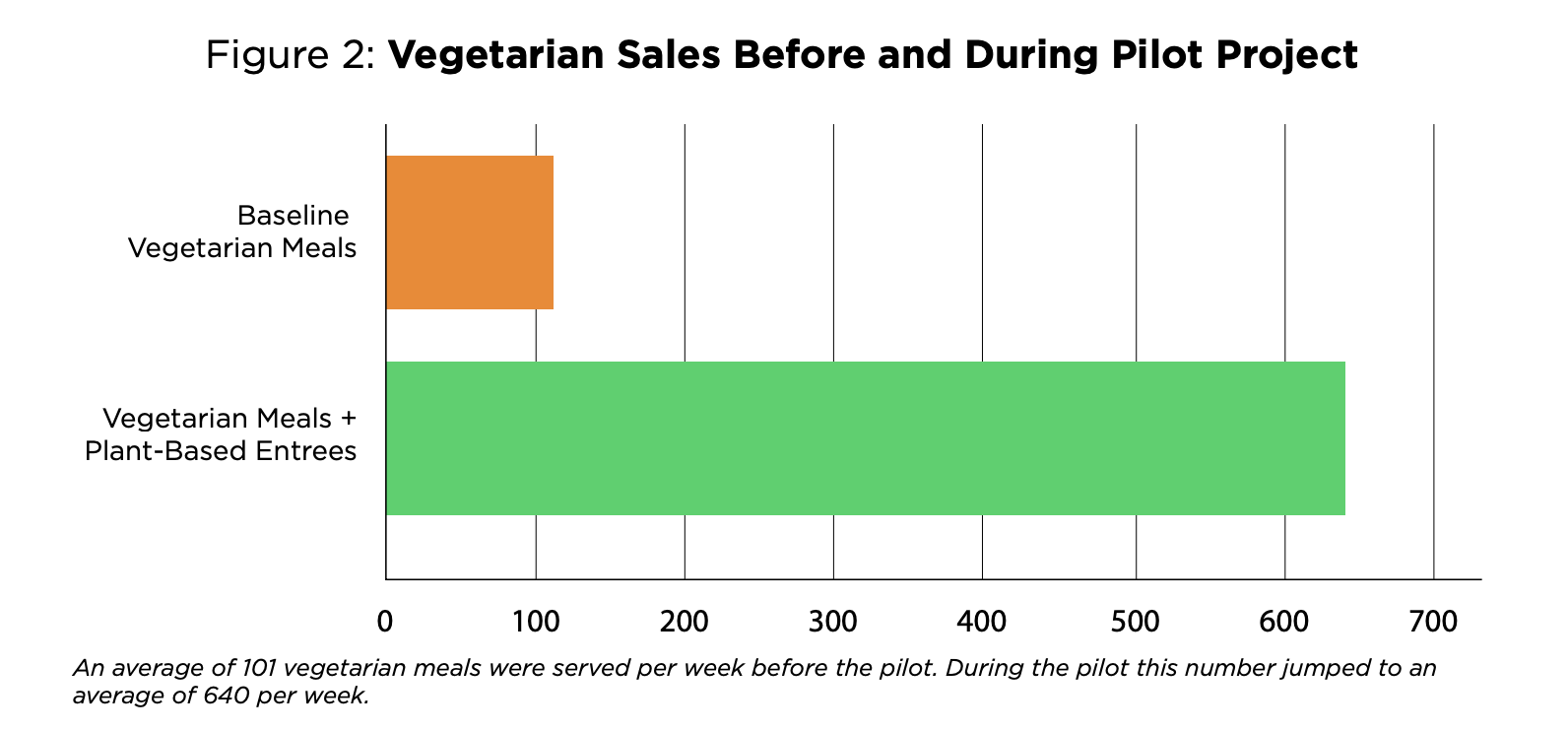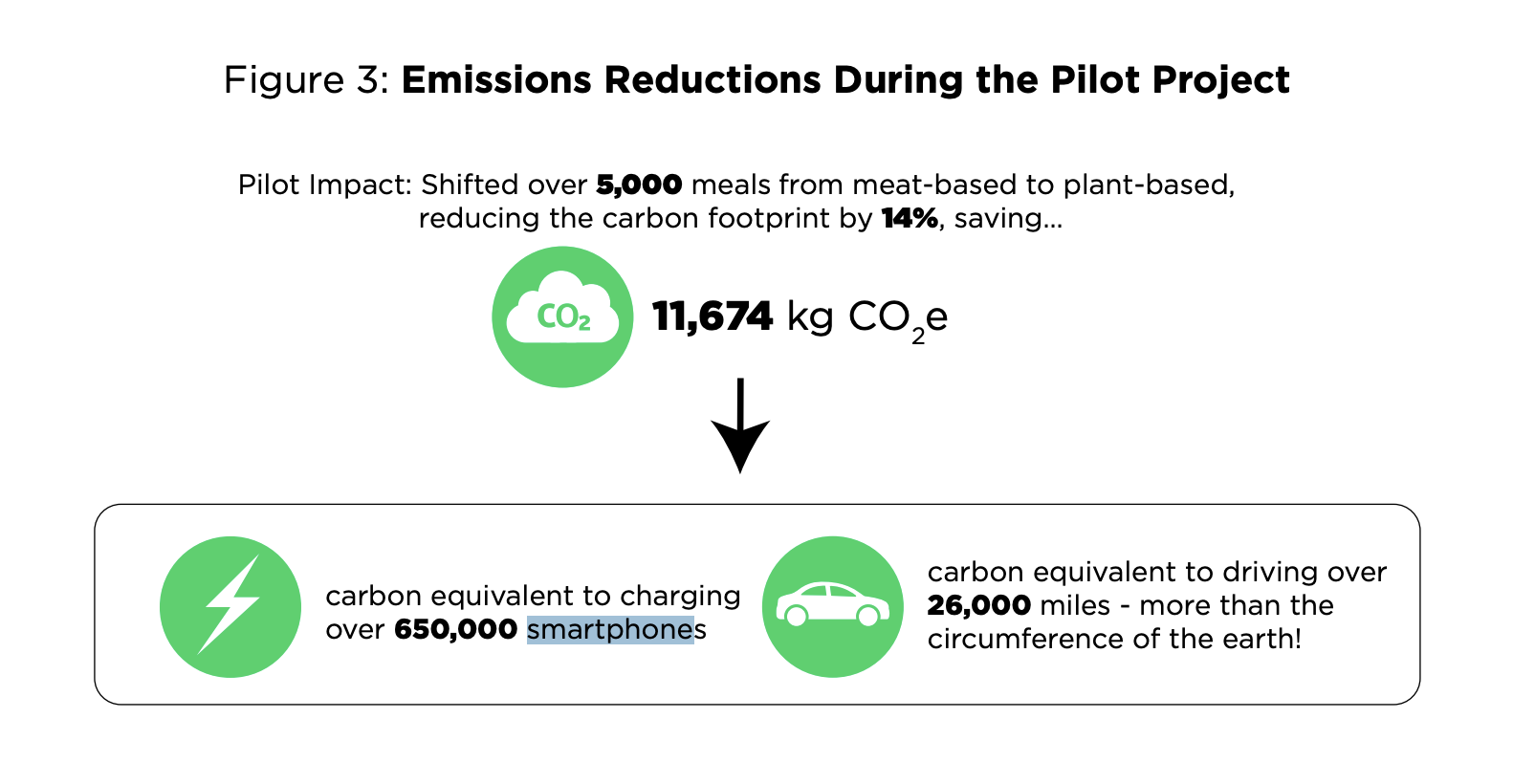The power of choice architecture: Successfully shifting consumers towards sustainable options
"It's not about taking away choices, but about making the sustainable choice the easy and appealing one.”
To say that changing people's habits can be tricky is an understatement. But compelling consumers to make climate-friendly decisions doesn’t necessarily have to be a complex undertaking when you abide by one simple, straightforward strategy: making the sustainable choice the easy choice. That's why we were so thrilled to team up with our friends at Friends of the Earth and Sodexo, a leader in delivering sustainable foodservice, to put that strategy to the test in a unique pilot study. The goal: To reduce a corporate cafeteria’s carbon emissions by nudging them towards more climate-friendly, plant-based meals—without anyone feeling like they were missing out.
The outcomes were even better than we had hoped.
The results, unveiled in a recent webinar Greener by Default hosted in conjunction with Friends of the Earth and Sodexo, offer clear, actionable strategies for institutions ready to shrink their carbon footprint. The secret sauce wasn’t about mandates or taking away diner favorites. It came down to three core concepts that everyone involved with the study embraced: the power of making delicious food easily accessible, the necessity of an empowered team, and a little menu psychology.
Want all the details? We were so excited by these results that we teamed up with our partners to capture all the data, insights, and lessons learned. You can dive deeper into the methodology and findings by reading the full joint report, "Promoting Sustainable Food Service Operations," here on the Friends of the Earth website.
1. Make it easy, and they will come: The magic of a simple nudge
People are busy, and when presented with a choice, they’ll often take the path of least resistance—and GBD and Friends of the Earth worked closely with Sodexo’s team on the ground to make that path the greener one.
That was the central idea behind our intervention at a bustling Sodexo-run cafeteria serving about 2,500 employees. We zeroed in on the most popular spot: the main entrée line. Before our project, this station was a trifecta of meat-based dishes—and for the eight weeks that comprised the pilot study, we simply swapped one of those meat dishes for a delicious plant-based option every day. No loud fanfare, no major overhauls—we just tweaked the landscape.
An average of 101 vegetarian meals were served per week before the pilot. During the pilot this number jumped to an average of 640 per week.
The results from this simple shift were significant: Plant-based sales skyrocketed from 2.3% to over 16% of total sales—a seven-fold increase, representing an extra 650 plant-based meals flying out of the kitchen every single week.
This wasn't just a win for veggies; it was a win for the planet: The menu shifts that frontline staff implemented slashed the cafeteria's carbon footprint by 14%, saving the equivalent of CO₂ from charging 650,000 smartphones. "It's not about taking away choices, but about making the sustainable choice the easy and appealing one,” said GBD CEO and Co-Founder Katie Cantrell on our joint webinar with Friends of the Earth and Sodexo. “By simply changing the default, we can guide people towards more climate-friendly options without them even realizing it." And on top of everything, the location’s share of revenue actually increased, demonstrating clearly that people weren’t just accepting the change—they were embracing it.
2. Your team on the ground are your MVPs
You can have the most effective strategy in the world, but it won't mean a thing without the people on the ground to bring it to life. This project hammered home a lesson we see time and again: your frontline staff are your superstars. Their buy-in and enthusiasm are non-negotiable for success.
We knew we couldn't just drop a new menu on cafeteria staff and walk away. That’s why our partners at Friends of the Earth led a fantastic training session and taste tests with the entire cafeteria team, working closely with them to get them on board and comfortable with the new menu items and structure. This wasn't just about memorizing ingredients; it was about building genuine excitement to prepare and serve the new dishes to their customers.
Lisa Gonzalez, Senior Food and Climate Policy Analyst at Friends of the Earth, put it perfectly during the webinar:
"Frontline staff are the face of the cafeteria. Their excitement and their ability to genuinely recommend a dish can make all the difference. When they've tasted the food and understand the 'why' behind the project, they become incredible ambassadors for sustainable eating."
Lisa Gonzalez, Friends of the Earth
And they really did: They became champions of the new dishes, armed with firsthand knowledge of how delicious they were and the benefits they offered for diners and for the planet. The training helped them understand the bigger picture, and their positive interactions with customers were a huge factor in the project's success.
3. Speak deliciously: The secret language of menus
Another major win came from applying tried-and-true behavioral science to the menu itself. Words matter, and how a foodservice operator describes a dish on a menu can be the difference between a curious customer ready to take a chance on something new, and a hard pass in favor of a more familiar animal-based option.
We learned quickly that what sells is comfort, familiarity, and downright deliciousness. Dishes that promised mouthwatering flavor like Buffalo Cauliflower and Creole Grits flew off the line, while more "virtuous"-sounding options like Stuffed Zucchini were less successful. This is choice architecture 101: meet people where they are.
Lisa Feldman, Senior Director of Culinary - Menu Systems and Impact Strategy at Sodexo, encapsulated this reality perfectly when she said:
"We're not just creating plant-based dishes; we're creating delicious dishes that happen to be plant-based. The focus has to be on flavor, satisfaction, and creating a positive dining experience. When the food is genuinely good, the fact that it's also better for the planet is a bonus."
Lisa Feldman, Sodexo
The updated menu items were very intentional in their language, ditching labels like "vegan" or "meatless" that can signal sacrifice in favor of using enticing descriptions that were more likely to make mouths water. We also played with placement, making sure the plant-based options were the first thing diners saw. These small tweaks can create a powerful psychological incentive to try out the delicious new dishes on offer.
In the end, the pilot was a resounding success, and proved that creating a more sustainable food system doesn't have to be a struggle. With smart design, an engaged team, and a focus on deliciousness, companies, culinarians, and frontline staff can make a measurable positive impact on their carbon footprints and the planet. Our collaboration with Friends of the Earth and Sodexo shows what's possible when you tackle food system change one delicious, climate-friendly meal at a time.
Read the report on our joint pilot study on Friends of the Earth’s website. Couldn’t make it to our webinar? View the recording here (passcode: lym^0E5y).
Greener by Default empowers institutions with evidence-based consulting and hands-on guidance to serve inclusive and delicious plant-forward menus that move the needle on health and sustainability, while protecting freedom of choice. GBD works primarily with hospitals and healthcare institutions, colleges and universities, corporate cafeterias, and large catered events, using behavioral science to nudge diners towards more sustainable, healthy, plant-based options by making them appealing, abundant, and accessible.
Interested in working with GBD? Start the conversation.





